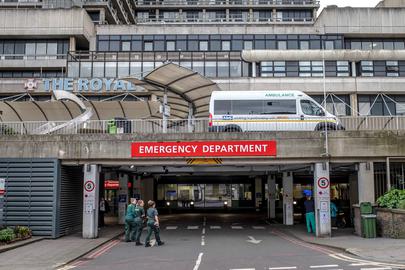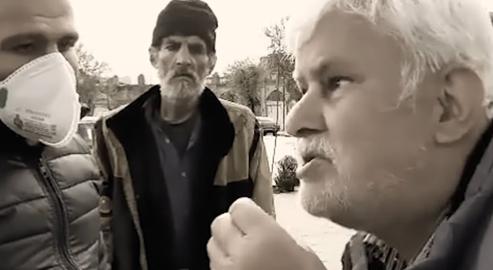In the scrubbed and sterile confines of a London hospital ward, an elderly woman comes to visit her husband for what will turn out to be their last evening together.
The man has COVID-19 and his condition has deteriorated badly. In his final hours, his wife has been forced to don a surgical mask, gloves and an apron to approach his bedside. The couple are not allowed to embrace, or kiss. They cannot see one another’s faces.
This exchange at the Royal Free Hospital, where 10 patients have so far died due to the coronavirus, has played out countless times before the eyes of frontline medics across the globe.
The supervising doctor in this case was 34-year-old Aarash Saleh, the son of an Iranian-born medic who despite years of experience said the exchange was “hard to bear.”
“I’m prepared for, and sad to say expecting, it to get a lot worse.” he says. “A much firmer hand should have been taken earlier."
At the time of writing the number of people known to be infected with coronavirus across the globe has just reached one million. Medical practitioners, commissioners, public health experts and an army of auxiliary staff on seven continents, from ambulance drivers to hospital porters, have scrambled to accommodate a deluge of hospital admissions for people with suspected COVID-19.
As frontline staff mobilize in the face of a novel disease that has changed the structure and face of acute care overnight, the outbreak of the coronavirus has also thrust entire healthcare systems into the spotlight. Early interventions in some jurisdictions such as South Korea have saved countless lives. But in others including Iran, disastrous mismanagement has already had fatal results.
Three months after the initial outbreak in China, the United States and the United Kingdom are now both firmly in the eye of the storm. The US has confirmed a quarter of a million cases and more than 6,000 deaths. In the United Kingdom close to 3,000 people are known to have died from the virus – the majority of which, in both countries, were tragically recorded in the past seven days. Official statistics, however, belie the true extent of the problem as testing is patchy and under-resourced. In both jurisdictions, too, there is a sense that had political figureheads not wavered before bringing in social distancing measures, more lives could have been saved.
This week IranWire spoke to three medical practitioners of Iranian origin with a combined 45 years of experience who are fighting coronavirus on the frontlines in the US and the UK.
Dr Joseph Rahimian, New York

New York is at the epicenter of the COVID-19 outbreak in the US. Close to 100,000 cases have been confirmed and New York has recorded a markedly higher death rate than other states: a projected 13 per 100,000, almost twice that of the next most severely-affected area, according to CNN. In a stark warning on March 25, Governor of New York Andrew Cuomo said the pandemic was spreading “like a bullet train” and claimed the state was 15,000 ventilators short. But after a period of rumination, US President Donald Trump surmised that quarantining the city is “not necessary.”
In New York hospitals medical professionals are now working around the clock to admit and treat people from all walks of life with COVID-19. Dr Joseph Rahimian, an infectious disease specialist at one of the city’s major treatment centers, has seen his own office closed and all but abandoned his regular duties to work flat-out on the wards.
Dr Rahimian, 47, lived in Iran for two years as a child before his family returned to the US after the 1979 Islamic Revolution. He has been a practicing physician for 16 years – in which time, he says, “I’ve never seen anything this disruptive to care.
“We’ve had disruptions like SARS and Ebola, and 9/11, and Hurricane Sandy, but the magnitude of this is unprecedented.”
Suspected COVID-19 infections have taken over “99 percent” of Dr Rahimian’s caseload. Entire wards have been converted to ICU-level and closed wards have re-opened.
The hospital has canceled many face-to-face appointments and converted to telemedicine instead, interacting with frightened members of the public via video calls.
Team members are facing up to the fact that while most patients admitted with COVID-19 will make a full recovery, a small number will not survive. “We need to know what people’s wishes are in the event that they get worse,” Dr Rahimian says.
“One of the big stresses is that visitors aren’t allowed in routinely anymore. A lot of people who have come in would normally have their family beside them.
“It’s emotionally taxing to see people sick and not have a quick fix. A lot of what I normally do is give people antibiotics and see them rapidly get better. But with this disease, there’s a sense of impotence.”
It took until March 14 for US President Donald Trump to declare a state of emergency. As of April 3, the premier has warned the US should brace for a “very painful” two weeks as officials predict up to 240,000 Americans could die.
For clinical staff in New York such as Dr Rahimian and his team, the evidence that the problem has been escalating, not abating, has been in front of them all along. “People aren’t leaving as fast as they’re coming in,” he says. “We could have done more earlier.”
Dr Aarash Saleh, London

On the evening of April 1, Dr Aarash Saleh was on the cusp of returning to work on hospital wards after an agonizing week of self-isolation at home.
The 34-year-old developed a cough in late March and in line with guidance issued to the public, he has been forced to stay off work for a seven-day quarantine period.
The decision to step away was a difficult one. Dr Saleh, whose parents left Iran just before the 1979 Revolution, is a respiratory doctor whose patients include those with asthma and chronic obstructive pulmonary disease: some of the most vulnerable to COVID-19. He works at the Royal Free Hospital, one of London’s flagship sites where some of the first British citizens to contract the virus were brought for treatment.
There are now more than 9,000 confirmed coronavirus cases in London and more than 20,000 retired National Health Service (NHS) staff have returned to work to help battle the virus.
Before going into quarantine, Dr Saleh had been arriving at 8am or 8pm for 12.5-hour shifts. As a registrar, in ordinary times he would be on the respiratory wards making care decisions, holding clinics and arranging investigative procedures such as bronchoscopies.
Now, he says: “It’s been completely turned upside down. The Royal Free went into emergency mode early on and most of the doctors were switched over into a big general rota, which is high-intensity and on the maximum legally permitted hours.”
Dr Saleh is now in charge of streaming new arrivals to the Royal Free and separating those who may have COVID-19 from other patients. On an ordinary shift, he has contact with about 25 patients.
“It’s very stressful,” he says. “There is an atmosphere of teamwork, and support and flexibility at the high levels. But there is also an undercurrent of fear."
NHS staff in the UK are equipped with the personal protective equipment (PPE) prescribed by Public Health England, which differs from that of the World Health Organization (WHO). While the WHO advises that all staff in contact with COVID-19 patients wear a full gown and visor, the PHE says this is only necessary in certain discreet situations.
“The disparity between the positions has led to some concern,” says Dr Saleh. “There’s a suspicion it’s driven by pragmatism.”
Dr Mehran Sina, Los Angeles

In a quarter-century-long medical career and as an Iranian-born citizen in the US, Dr Mehran Sina never anticipated being in a position in which he would support martial law.
The 53-year-old is an internist at the Kaiser Permanente West Los Angeles Medical Center in Los Angeles, California. He and his family hail from Urmia and fled in 1979 in fear of persecution because of their Jewish faith. After a stint in Israel, they settled in the US in 1983.
“I came from a repressive, anti-semitic regime and I appreciate the value of freedom,” Dr Sina says. “But at some point, for the good of the many we have to limit some freedoms.
“As of today I’ve been advocating for military rule with armed personnel on the street. The message [to stay inside] has gone nowhere. I cringe when I see people having parties, and spring break, and Mardi Gras. It’s burying your head in the sand.”
As an internist, Dr Sina’s working day would normally feature a mixture of clinical and administrative work, on a straight 8am to 5pm or 8am to 8pm shift pattern.
Now he is at the hospital seven days a week, and for three nights a week. “An increasing number are coming in with respiratory symptoms,” he says. “We see the same movie play over and over again.
“Some improve: the fever clears and thank God, we have discharged many that got better. But we have had a couple of patient deaths and many more in the ICU are critical.”
The pandemic has spread rapidly across California, with 250 deaths recorded so far, of more than 11,000 confirmed cases. The Kaiser Permanente hospital where Dr Sina works has been in all-out “preparation mode,” ordering 100,000 new sets of scrubs, creating a new changing area for staff at the entrance, and canceling all non-urgent procedures.
Dr Sina also says that in 24 years, “I’ve never seen anything like this. We’re experienced in managing surges, but never to this extent.”
And What of Iran?
Despite their strong family and personal ties to Iran, not one of the three doctors interviewed by IranWire felt they could advance a strong opinion on the Iranian government’s chaotic handling of the domestic coronavirus outbreak. At the last count Iran had more than 53,000 cases and 3,000 COVID-19 linked deaths, though the true figure is thought to be much higher.
For his part, Dr Joseph Rahemian said, there was nothing to be learned in the US from following the course of events in Iran. “It’s very clear they under-reported what was happening and we don’t know what their experience has truly been,” he said.
Dr Mehran Sina in Los Angeles was more forthright: “I’d assume you can trust about 50 percent of what they say.”
visit the accountability section
In this section of Iran Wire, you can contact the officials and launch your campaign for various problems































comments